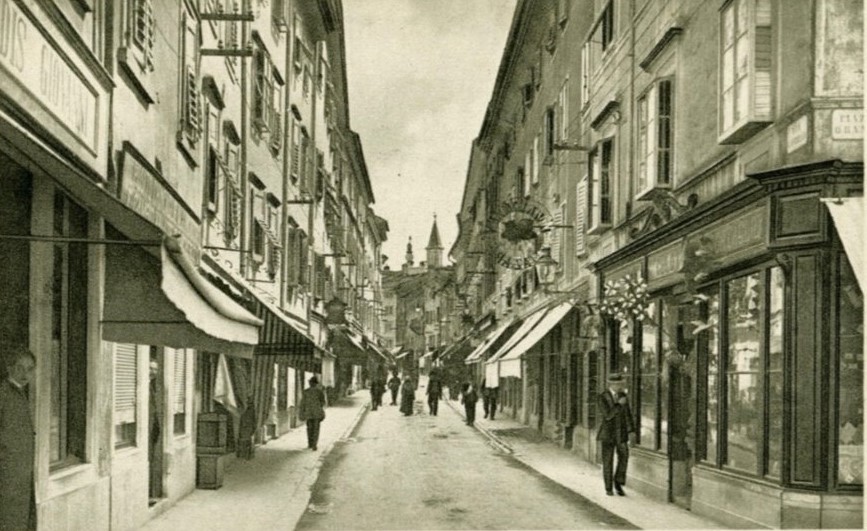Learn More

From 1781, with Joseph II’s Edict of Toleration, several restrictions against the Jews were abolished, including the requirements to live in a ghetto, to wear an outward mark of one’s Jewishness, and the ban on practicing manual trades. Jews were allowed to study at state schools and universities (apart from in the Theology Faculty). Thanks to the Judenordnung in 1790 and to the freedoms granted during the Napoleonic invasions (1797-1813), Gorizian Jews began to experience the Emancipation, which arrived definitively shortly after 1867. Napoleon removed the gates to the ghettos.
In 1850 there were 314 Jews in Gorizia, the highest number there had ever been in the city. 226 of these lived in the area of the old ghetto, which at that time was an important commercial hub and was, importantly, close to the Synagogue.
In 1893 the Jewish Community of Gradisca was amalgamated with that of Gorizia.
Following the First World War, the Jewish Community changed drastically, with numbers plummeting: many people died in the conflict, especially younger people, and several Italian members decided to move to more important cities. However, several Jews from Eastern Europe joined, fleeing Tzarist antisemitism. There was a general impoverishment, through which they were supported by the Jewish Community of Trieste, especially Carlo Nathan Morpurgo, who was a member of the Assistance Committee for Jewish emigrants in the 1920s and Community Secretary from 1939.
With the Falco Law of 1930 the Italian Jewish Communities were reorganised and those of Udine and San Daniele del Friuli were merged with the Jewish Community of Gorizia.
In 1938 there were 183 Jews in the Gorizian area. The fascist racist laws prohibited students who were considered of the “Jewish race” from studying at state schools. In Gorizia, since there was no longer a Jewish school, the teacher Rina Luzzatto (who was deported and murdered at Auschwitz), and the young Marcello Morpurgo took over the education of Jewish children.
On 17 September Mussolini visited Gorizia and gave a speech in Piazza Vittoria. Marcello Morpurgo was there and perfectly recalled the antisemitic and, above all, anti-Slovenian atmosphere of the time.
Almost annihilated by the deportations under the Nazi occupation, the Jewish Community was helped after the Liberation by members of the Jewish Brigade and Jewish soldiers in the American Army who were temporarily based in the area.
Marcello Morpurgo thus recalls the difficult return to normal life: “We find ourselves without housing, without furniture or furnishings, without anything, with just the very little we had with us, and even that is worn out with time and use. But how can we lament this, when so many have lost their lives? Such things count for little compared to the physical suffering, the hardships and the atrocious murder of those who were deported.” [p. 193].
In 1969 the Jewish Community of Gorizia had very few members and was merged with that of Trieste.
SOURCES:
Orietta Altieri, La comunità ebraica di Gorizia: caratteristiche demografiche, economiche e sociali (1778-1900), Del Bianco, Udine 1985
Giuseppe Bolaffio, Sfogliando l’archivio della Comunità di Gorizia, in “La Rassegna Mensile Di Israel”, vol. 23, no. 12, 1957
Chiara Lesizza Budin, Vita e cultura ebraica nella Gorizia del Settecento, Edizioni della Laguna, Mariano del Friuli 1995
Adonella Cedarmas, La Comunità israelitica di Gorizia. 1900-1945, Istituto Friulano per la Storia del Movimento di Liberazione, Udine 1999
Miriam Davide and Pietro Ioly Zorattini (eds), Gli ebrei nella storia del Friuli Venezia Giulia. Una vicenda di lunga durata, Giuntina, Florence 2016
Marcello Morpurgo, Valdirose. Memorie della Comunità ebraica di Gorizia, Del Bianco, Udine 1986
Translation from Italian to English by Bethany Gaunt
Project by
Jewish Community of Trieste and Ca’ Foscari University Venezia
Info
visit@triestebraica.it
